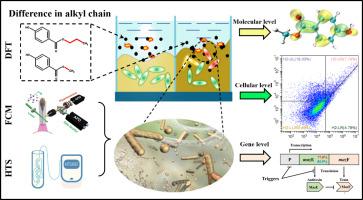Science of the Total Environment ( IF 8.2 ) Pub Date : 2023-03-31 , DOI: 10.1016/j.scitotenv.2023.163168 Sheng Liu 1 , Peifang Wang 2 , Chao Wang 2 , Juan Chen 2 , Xun Wang 2 , Bin Hu 2 , Xiaorong Shan 3

|
As emerging organic pollutants, parabens are of global concern because of their ubiquitous presence and adverse effects. However, few researchers have addressed the relationship between parabens' structural features and toxicity mechanisms. This study conducted theoretical calculations and laboratory exposure experiments to uncover the toxic effects and mechanisms of parabens with different alkyl chains in freshwater biofilms. The result demonstrated that parabens' hydrophobicity and lethality increased with their alkyl-chain length, whereas the possibility of chemical reactions and reactive sites were unchanged despite the alkyl-chain length alteration. Due to the hydrophobicity variation, parabens with different alkyl-chain presented different distribution patterns in cells of freshwater biofilms and consequently induced distinct toxic effects and led to diverse cell death modes. The butylparaben with longer alkyl-chain preferred to stay in the membrane and altered membrane permeability by non-covalent interaction with phospholipid, which caused cell necrosis. The methylparaben with shorter alkyl-chain preferred to enter into the cytoplasm and influence mazE gene expression by chemically reacting with biomacromolecules, thereby triggering apoptosis. The different cell death patterns induced by parabens contributed to different ecological hazards associated with antibiotic resistome. Compared with butylparaben, methylparaben was more likely to spread ARGs among microbial communities despite its lower lethality.
中文翻译:

淡水生物膜中具有不同烷基链长度的对羟基苯甲酸酯的不同毒性机制:与抗生素耐药性相关的生态危害
作为新兴的有机污染物,对羟基苯甲酸酯因其无处不在的存在和不良影响而受到全球关注。然而,很少有研究人员探讨对羟基苯甲酸酯的结构特征与毒性机制之间的关系。本研究通过理论计算和实验室暴露实验来揭示淡水生物膜中具有不同烷基链的对羟基苯甲酸酯的毒性作用和机制。结果表明,对羟基苯甲酸酯的疏水性和杀伤力随其烷基链长度的增加而增加,而尽管烷基链长度发生变化,化学反应的可能性和反应位点却没有变化。由于疏水性的变化,具有不同烷基链的对羟基苯甲酸酯在淡水生物膜细胞中呈现出不同的分布模式,从而诱导不同的毒性作用并导致不同的细胞死亡模式。烷基链较长的对羟基苯甲酸丁酯更倾向于留在细胞膜中,通过与磷脂的非共价相互作用改变细胞膜的通透性,从而导致细胞坏死。烷基链较短的对羟基苯甲酸甲酯优先进入细胞质影响maz E基因表达通过与生物大分子发生化学反应,从而引发细胞凋亡。对羟基苯甲酸酯诱导的不同细胞死亡模式导致了与抗生素耐药性相关的不同生态危害。与对羟基苯甲酸丁酯相比,对羟基苯甲酸甲酯更有可能在微生物群落中传播 ARG,尽管其致死率较低。











































 京公网安备 11010802027423号
京公网安备 11010802027423号